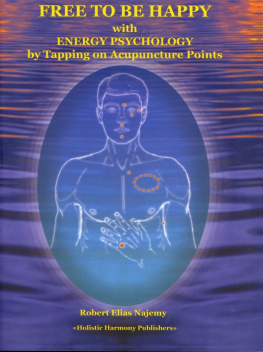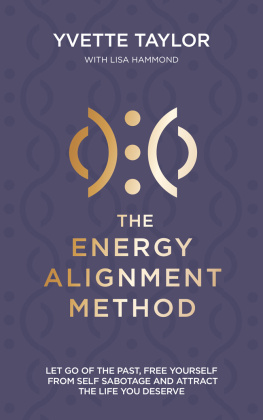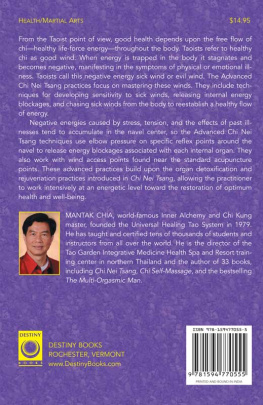Newton emphasized, If I have seen further than others, it is by standing upon the shoulders of giants. Similarly, if what I have written has more to offer those who suffer from trauma, it is because it rests on heritage. Therefore I would like to acknowledge all who contributed to this work, even those whom I have not personally met.
I am grateful to those who discovered our bodys energy system as an access to health and happiness. I am also grateful to George J. Goodheart, John Thie, John Diamond, Roger Callahan, and others who have pioneered the use of this system in the mission of helping others.
I would also like to thank my wife, family, friends, and colleagues for their support and encouragement throughout the writing of this book. I would also like to thank David and Justin Lee for their assistance with the illustrations used in Energy Tapping for Trauma.
Finally, thank you to all the talented people at New Harbinger Publications, including Matt McKay, publisher, and Jess OBrien, acquisitions editor. Special appreciation and acknowledgment go to Heather Mitchener, editorial director, and Jean M. Blomquist, copyeditor, for their energetic attention throughout the writing of this book.
Appendix A: Acronyms
Acupoints/Tapping Techniques
Aarmpit, toward the front
BBBrain Balancer
BHback of hand
CHon the upper chest, upper part of sternum (over the thymus gland)
EBbeginning of eyebrows near bridge of nose
EERElaborated Eye Roll
EREye Roll
GTinside edge of big toenails
IAupper edge of the inner ankle bones
IFinside tip of either index fingernail
LFinside tip of either little fingernail
LTlittle toenail
SHside of hand
SNside of nostril (either side of nose on the face)
SSsore spot (a tender spot between the second and third ribs above the breast on the left side of the chest).
TEthird-eye point, between and slightly above the eyebrows
UAsix inches under one or both armpits
UBLunder bottom lip
UCBunder one or both collarbones next to sternum
UEunder one or both eyes on the bony orbit
UKunder knee
UNunder nose
Other Terms
ADHDattention-deficit/hyperactivity disorder
AEPAdvanced Energy Psychology
AKapplied kinesiology
ASDacute stress disorder
BKbehavioral kinesiology
BPSbest possible self
CAPscomplementary and alternative psychotherapies
CBTcognitive behavioral therapy
CNScentral nervous system
DESdisorders of extreme stress
DIDdissociative identity disorder
ECTEnergy Consciousness Therapy
EDenergy disorganization
EDxTMEnergy Diagnostic and Treatment Methods
EFTemotional freedom techniques
EMDReye movement desensitization and reprocessing
EMIeye movement integration
EPenergy psychology
ESPEight-Step Process
ESRemotional stress release
ETenergy tapping
EvTFTevolving thought field therapy
FOHfrontal/occipital holding
HBLUHealing from the Body Level Up
HELPHealing Energy Light Process
HRVheart-rate variability
ICAKInternational College of Applied Kinesiology
LODlevel of discomfort
LOHlevel of happiness
MAOImonoamine oxidase inhibitor
METMidline Energy Treatment
MTBImild traumatic brain injury
NAEMNegative Affect Erasing Method
PRpsychological reversal
REBTrational emotive behavior therapy
SNDRIserotonin, norepinephrine, and dopamine reuptake inhibitor
S-Rstimulus-response
SSNRIselective serotonin and norepinephrine reuptake inhibitor
SSRIselective serotonin reuptake inhibitor
SUDsubjective units of discomfort (or distress)
SUGsubjective units of gratitude
SUUsubjective units of upset
TCAstricyclic and tetracyclic antidepressants
TFHtouch for health
TFTthought field therapy
TIRtraumatic incident reduction
TRTTrauma Removal Technique
USPUnified Self Process
V/KDvisual-kinesthetic dissociation
Appendix B: Research in Energy Psychology
The first reported research in energy psychology (EP) was a case report from 1980, and since that time the number of reports has grown steadily. Several additional case examples are noted in this book. See the discussions about Barbara, Bill, Amanda, and Carl in .
Case Reports
The first case report from Dr. Roger J. Callahan was about Mary, who had a severe water phobia from early childhood (Gallo 2005). Mary had difficulty taking a bath, could not go out of the house when it was raining, and had weekly nightmares about water consuming her. This phobia appeared to be hereditary, since she had it all her life and there was no evidence of a traumatic event. Mary was in treatment for about eighteen months and experienced little progress even after a variety of therapy techniques were tried with her. After a period of cognitive therapy, hypnosis, and behavior therapy, she eventually was able to sit near the shallow end of a swimming pool and dangle her feet in the water. However, she could not look at the water and she would get a severe headache after each session.
Given such little progress, Dr. Callahan decided to try a new approach with her based on applied kinesiology (AK) and acupressure. He asked her to think about water while he gently tapped on the bony orbits under her eyes with his fingertips. Within a minute or so, Mary said that she no longer got a sick feeling in her stomach while thinking about water. She then went outside to the swimming pool, looked at the water, and with delight she vigorously splashed water in her face! Marys fear of water remained permanently cured after the few minutes of this odd therapy.
Clinical Research
While case studies are interesting and informative, they are not considered to be scientific proof of the effectiveness of a therapeutic approach. It is possible that the success with Mary, Barbara, Bill, and other clients treated with EP was due to factors other than the tapping. For example, since individual cases do not include a placebo control group, the placebo effect is a possible explanation. Placebo effect suggests that the reasons the patients got better was because they believed that EP was going to help them. But why didnt they believe in the other established approaches that were used with them? Its likely that placebo effect would have occurred earlier. The therapists enthusiasm or the accumulative effects of all the therapy done with these patients might be plausible explanations too. But why would therapists use methods that they didnt feel positive about? I find these and other explanations difficult to accept. Rather, I firmly believe that the tapping while attuning the trauma or other psychological problem made it possible for these patients to get better so quickly.
Nevertheless, from the standpoint of science more is needed before an approach can be considered to be widely effective. Although there have been over a dozen studies on EP, only a few have been published in scientific journals. Several studies have supported the effectiveness of EP in the treatment of phobias and anxiety disorders, including fear of heights (acrophobia), blood-injection-injury phobia, public speaking anxiety, and post-traumatic stress disorder (PTSD), in addition to a variety of other psychological problems.
In 1987, an informal study showed significant decrease in subjective units of discomfort (SUD) of call-in subjects treated with thought field therapy (TFT) on radio talk shows (Callahan 1987). This study was later replicated by Dr. Glen Leonoff, who obtained equivalent results (Leonoff 1996). However, these were not highly scientific studies, since they could not include control groups, placebo treatments, follow-up evaluations, or other measures that are typically included in scientific experiments. Although many researchers would dismiss these studies, since they only showed a decrease in SUD, it is interesting that the same criticism is not raised when a study shows that a tranquilizer relieves anxiety. Most follow-up studies would not support the effectiveness of the tranquilizer in relieving the anxiety after the drug has been discontinued. Nevertheless, the ability of a treatment to give temporary relief is considered acceptable by the medical community and the patient.









